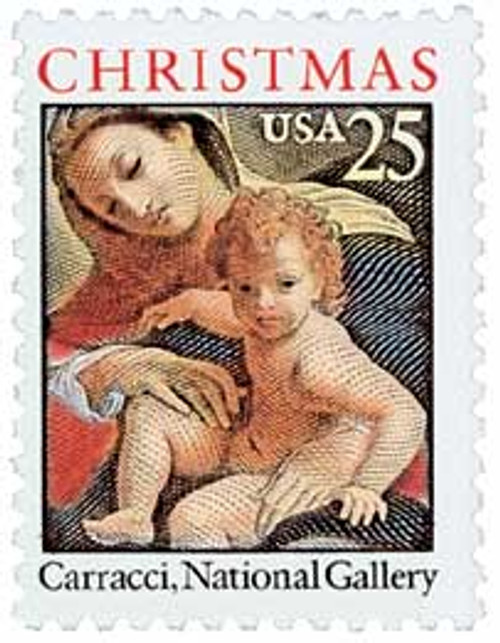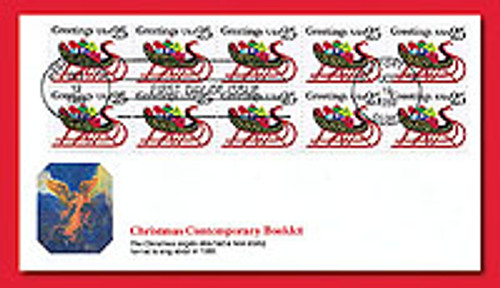
# 2427a - 1989 25c Christmas Madonna/pane of 10
U.S. #2427a
1989 25¢ Madonna and Child by Carracci
Traditional Christmas
- 23rd Traditional Christmas stamp
- This marked the first year the Traditional Christmas stamp was available in both sheet and booklet form (#2427a is the booklet stamp)
Stamp Category: Commemorative
Series: Traditional Christmas
Value: 25¢, first-class rate
First Day of Issue: October 19, 1989
First Day City: Washington, DC
Quantity Issued: 14,479,500 booklets
Printed by: Bureau of Engraving and Printing
Printing Method: Lithographed and engraved
Format: Panes of 50 in sheets of 300
Perforations: 11¼
Why the stamp was issued: For use on holiday mail.
About the stamp design: As he had many times before, Bradbury Thompson adapted a portion of a Renaissance masterpiece for this Traditional Christmas stamp. The stamp pictures the Madonna and Child detail of Ludovico Carracci’s painting, The Dream of St. Catherine of Alexandria. The booklet stamp can be distinguished from the sheet stamp in that each booklet stamp has at least one straight edge.
First Day City: The First Day ceremony for this stamp was held at the national Gallery of Art in Washington, DC, where the painting on the stamp hangs.
Unusual fact about this stamp: Error versions of this stamp have been found imperforate and with the red lithography missing.
About the Traditional Christmas Series: In 1966, the Post Office issued its first Madonna and Child stamp, a 15th century painting by Flemish painter Hans Memling. The stamp was very popular and over 1.1 billion were printed. This led the Post Office to issue another traditional Christmas stamp in 1968, this time picturing the Angel Gabriel. In 1969, they went back to more contemporary holiday subjects before finally deciding in 1970 to issue one Traditional Christmas stamp and one Contemporary Christmas stamp. Their decision proved popular and they’ve continued to issue both Traditional and Contemporary Christmas stamps ever since.
History the stamp represents: The stories of Jesus’ birth in Bethlehem of Judea are described in the gospels of Luke and Matthew. Each year, the story of Jesus’ early life is retold during the Christmas season. Denied a room at the inn, Joseph and Mary found refuge in a nearby stable, where Jesus was born. The Magi, or Wise Men, had traveled a great distance to find the “King of the Jews.” They honored the child with expensive gifts of gold, frankincense, and myrrh. But Herod, the ruler of Israel, worried about losing his throne to a potential rival, so he plotted to destroy Jesus. Joseph, Jesus’ earthly father, was warned of Herod’s plot in a dream and was instructed to take his family to Egypt, beyond the reach of the brutal king. The young family began the 200-mile journey immediately, not daring to wait until sunrise. The Wise Men’s precious gifts provided for the family’s needs during their flight into Egypt.
The Bible gives few specifics about the family’s trip, but traditional stories provide details. Mary became hungry while they were traveling through the desert. Jesus commanded a palm tree to bend down so his mother could reach some dates and satisfy her need. Another legend tells of a temple filled with idols. The objects of worship fell to the ground and broke when Jesus passed by. Churches now mark the locations where it is believed Jesus stayed, giving followers places to reflect on the Holy Family’s flight to safety.
U.S. #2427a
1989 25¢ Madonna and Child by Carracci
Traditional Christmas
- 23rd Traditional Christmas stamp
- This marked the first year the Traditional Christmas stamp was available in both sheet and booklet form (#2427a is the booklet stamp)
Stamp Category: Commemorative
Series: Traditional Christmas
Value: 25¢, first-class rate
First Day of Issue: October 19, 1989
First Day City: Washington, DC
Quantity Issued: 14,479,500 booklets
Printed by: Bureau of Engraving and Printing
Printing Method: Lithographed and engraved
Format: Panes of 50 in sheets of 300
Perforations: 11¼
Why the stamp was issued: For use on holiday mail.
About the stamp design: As he had many times before, Bradbury Thompson adapted a portion of a Renaissance masterpiece for this Traditional Christmas stamp. The stamp pictures the Madonna and Child detail of Ludovico Carracci’s painting, The Dream of St. Catherine of Alexandria. The booklet stamp can be distinguished from the sheet stamp in that each booklet stamp has at least one straight edge.
First Day City: The First Day ceremony for this stamp was held at the national Gallery of Art in Washington, DC, where the painting on the stamp hangs.
Unusual fact about this stamp: Error versions of this stamp have been found imperforate and with the red lithography missing.
About the Traditional Christmas Series: In 1966, the Post Office issued its first Madonna and Child stamp, a 15th century painting by Flemish painter Hans Memling. The stamp was very popular and over 1.1 billion were printed. This led the Post Office to issue another traditional Christmas stamp in 1968, this time picturing the Angel Gabriel. In 1969, they went back to more contemporary holiday subjects before finally deciding in 1970 to issue one Traditional Christmas stamp and one Contemporary Christmas stamp. Their decision proved popular and they’ve continued to issue both Traditional and Contemporary Christmas stamps ever since.
History the stamp represents: The stories of Jesus’ birth in Bethlehem of Judea are described in the gospels of Luke and Matthew. Each year, the story of Jesus’ early life is retold during the Christmas season. Denied a room at the inn, Joseph and Mary found refuge in a nearby stable, where Jesus was born. The Magi, or Wise Men, had traveled a great distance to find the “King of the Jews.” They honored the child with expensive gifts of gold, frankincense, and myrrh. But Herod, the ruler of Israel, worried about losing his throne to a potential rival, so he plotted to destroy Jesus. Joseph, Jesus’ earthly father, was warned of Herod’s plot in a dream and was instructed to take his family to Egypt, beyond the reach of the brutal king. The young family began the 200-mile journey immediately, not daring to wait until sunrise. The Wise Men’s precious gifts provided for the family’s needs during their flight into Egypt.
The Bible gives few specifics about the family’s trip, but traditional stories provide details. Mary became hungry while they were traveling through the desert. Jesus commanded a palm tree to bend down so his mother could reach some dates and satisfy her need. Another legend tells of a temple filled with idols. The objects of worship fell to the ground and broke when Jesus passed by. Churches now mark the locations where it is believed Jesus stayed, giving followers places to reflect on the Holy Family’s flight to safety.










